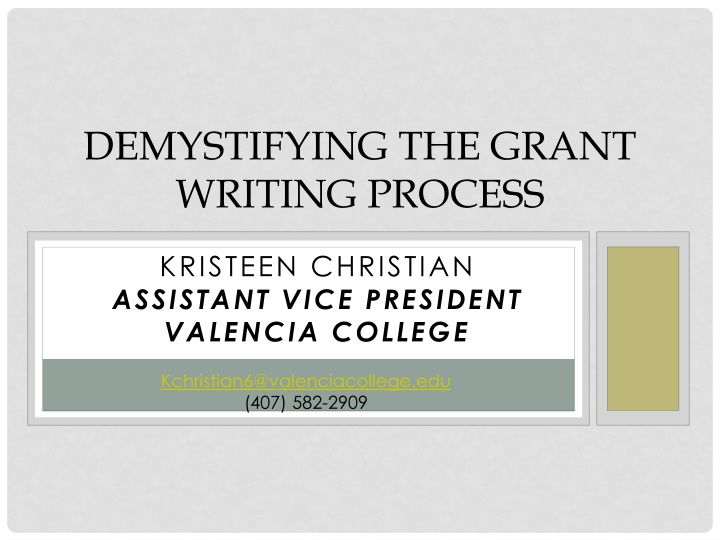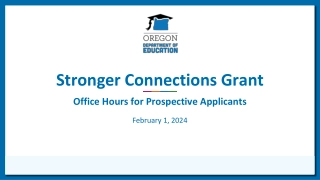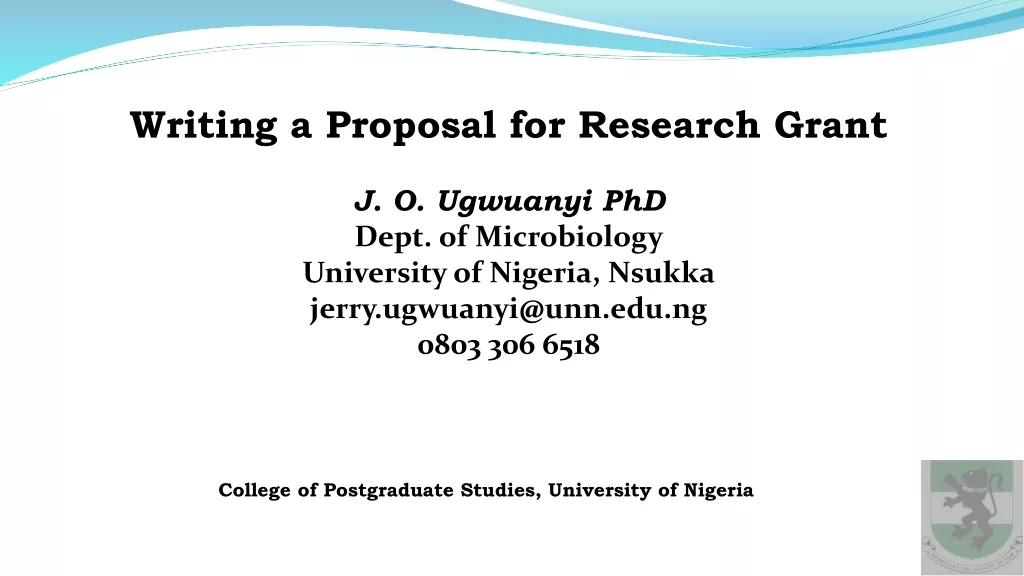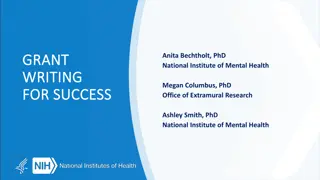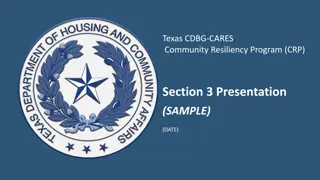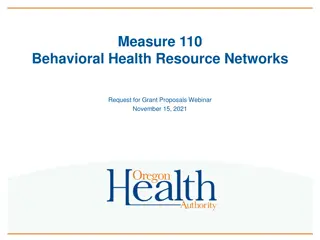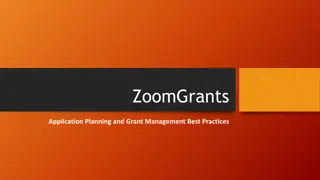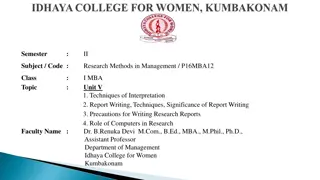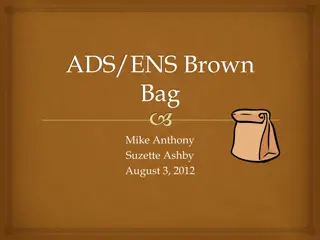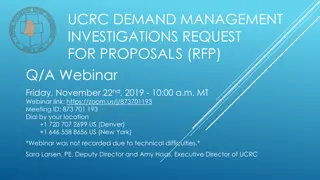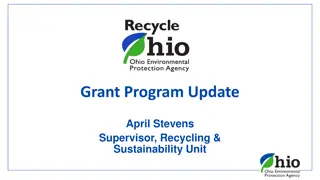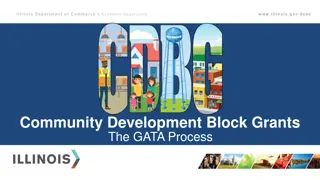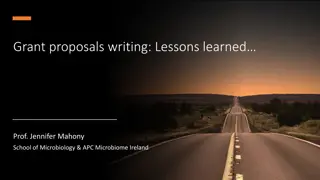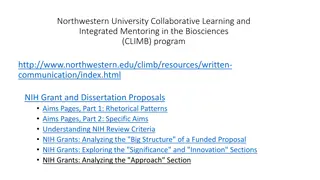Grant Writing Guide for Effective Proposals
Unlock the secrets of successful grant writing with an in-depth look at the components of a grant proposal, where to start your proposal, how to identify significant needs, gather supporting data, assess problem significance, and set measurable objectives. Gain valuable insights into formulating problem statements, defining goals vs. objectives, and ensuring your proposal addresses key causes for maximum impact. Elevate your grant writing skills and increase your chances of securing funding effectively.
Download Presentation

Please find below an Image/Link to download the presentation.
The content on the website is provided AS IS for your information and personal use only. It may not be sold, licensed, or shared on other websites without obtaining consent from the author.If you encounter any issues during the download, it is possible that the publisher has removed the file from their server.
You are allowed to download the files provided on this website for personal or commercial use, subject to the condition that they are used lawfully. All files are the property of their respective owners.
The content on the website is provided AS IS for your information and personal use only. It may not be sold, licensed, or shared on other websites without obtaining consent from the author.
E N D
Presentation Transcript
DEMYSTIFYING THE GRANT WRITING PROCESS KRISTEEN CHRISTIAN ASSISTANT VICE PRESIDENT VALENCIA COLLEGE Kchristian6@valenciacollege.edu (407) 582-2909
COMPONENTS OF A GRANT PROPOSAL Abstract or summary Introduction or organization background Problem or need statement Project Goals and Objectives
COMPONENTS OF A GRANT PROPOSAL Methods or implementation strategy Key personnel Project evaluation Project budget and budget narrative Sustainability plan
WHERE TO START Identify a significant need Does the significant need impact your students, department, organization, or community?
HOW DO YOU KNOW? What data supports your need? Is this a local, state, national need? Is there comparative data?
HOW SIGNIFICANT IS THIS PROBLEM? List all of the long-term implications if this problem is not addressed.
SO THERE IS A PROBLEM Now ask What are the possible causes for this problem? Make a list! Can you categorize the causes? Is it an access or information problem? Lookat your list again What items are out of your control? Strike those!
PROBLEM STATEMENT The list left should be items that you have control or influence over.
THINK ABOUT THIS Is the problem measurable? The causes will be addressed in the methods section of the proposal. This is an important connection!!!
GOALS Goals are large statements of what you hope to accomplish or see. Goals are not measurable. Goals create the setting for the proposal.
OBJECTIVES Objectives are operational and measurable. Two kinds of objectives: Outcome objectives Process objectives
OUTCOME OBJECTIVES Outcome objectives measure program s effectiveness
PROCESS OBJECTIVES Process objectives measure the steps that the organization is taking to meet the goal. Examples of process objectives: To establish To attend To purchase To implement To train
IMPORTANT To increase or decrease something is not an objective. To make it an objective add by what degree the increase or decrease will happen. All outcomes must be written in terms of the participants or learners, not the organization!!!
USE THE S.M.A.R.T. APPROACH Specific Measurable Action Oriented Realistic Time and resource limited
METHODS/ACTIVITIES/IMPLEMENTATI ON This is the most detailed part of the proposal and scored the most points. It describes who, what, when and how List all of the tasks/activities Who is responsible Add the timeline How will you know this is accomplished?
EVALUATION Relates to the goals, objectives, and outcomes of the proposal. Begin with the evaluation in mind
EVALUATION CONSIDERATIONS What data will be needed? Who and how will the data be collected and used? What measures will be used to collect the data? Is an outside evaluator needed or required?
TWO TYPES OF EVALUATION Formative evaluation is part of the implementation plan. Summative evaluation asks, have you achieved the outcome objectives?
"WHEN THE COOK TASTES THE SOUP, THAT S FORMATIVE; WHEN THE GUESTS TASTE THE SOUP, THAT S SUMMATIVE." - ROBERT STAKES
MEASURES Focus groups Surveys, questionnaires, checklists Pre-post tests Anecdotal information Case studies Interviews
BUDGET - A PICTURE OF THE PROPOSAL USING NUMBERS Must relate to the activities in the grant proposal Be realistic
BUDGET ITEMS Personnel - salary and fringes Consultant and contractual Travel Supplies Equipment Other Indirect costs Administrative costs
A WORD ABOUT SUSTAINABILITY A sustainability plan must be included in the proposal. Highest level of governance must agree to the plan.
REMEMBER Read the RFP carefully and make notes. Most important information first. Use specific examples. Vague signals poor planning. Use grandma s rule!!!
GRANT PROPOSALS/AWARDS Will be rejected more than funded. Are an investment for the funding source. Offer -0- budget relief. Funding sources want to fund something unique, not current operating expenses. Are seed money for new projects. Not a short-term problem solving for long-term problems.
PROVE TO THE FUNDING SOURCE THAT YOU: Have a broad based understanding of the problem. Have read and understand the current literature in your discipline. Are qualified to design and deliver a solution to the problem. Have a reasonable plan and budget! You have a plan for sustainability
WINNING PROPOSALS Overwhelm the reader with hard core facts and details. Bring the proposal to life - add stories and visuals. Textboxes often do not follow same formatting!
